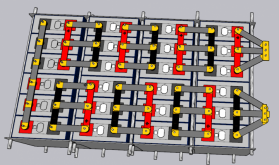I am struggling with 2 fixture design issues I would appreciate anyone’s perspective on (and especially those that actually have a working fixture already):
1/ single-rod vs. dual rod: I was originally thinking I would go with a single-rod design, meaning one pair of threaded rods compressing a horizontal 1-1-4” square tube on either end (crossing the middle of plastic of wooden ‘ends’) but I’m now worried that design may allow the ends to tip/angle so that expansion at the bottom of the cells may exceed expansion at the top of the cells. I’m not sure a bit of ‘accordion’ expansion is a problem (and have the flexible busbars to accommodate it) but the dual-rod design (meaning 2 square tubing braces per end) assures more uniform pressure and the only negative is the additional cost.
2/ single-spring vs. dual-spring: with a spring on only one end, the cell farthest from the spring is only going to move ~1/4mm while the cell closest to the spring will move ~3-1/2mm (for my 8S pack), while with a half-length spring on either-end of each rod, the two central cells will only move ~1/4mm while the outermost cells will only move ~1-3/4mm. Less movement is probably good, more symmetrical movement is probably good, but the main thing making me think I may want to put springs on either end of each tod is that that means the rods themselves don’t move and can be used as the primary support beams for the entire structure with the cells themselves just ‘floating’ in between the two pressurized endcaps. It means twice as many springs but if they cost 1/2 as much, it’s pretty much a no-brainer. If the total investment on springs is double, I’m not sure the minor benefits would be worth it.
I think the flexing issue has been "answered" but I can tell you that my 0.6" plywood flexed in the middle with my 4-rod construction before I added the square tubes. Imagine hanging the board 4" off the end of the table and then placing 300 pounds of pressure at the end - would it flex at all? even 1mm of flex throws all the calculations off.



